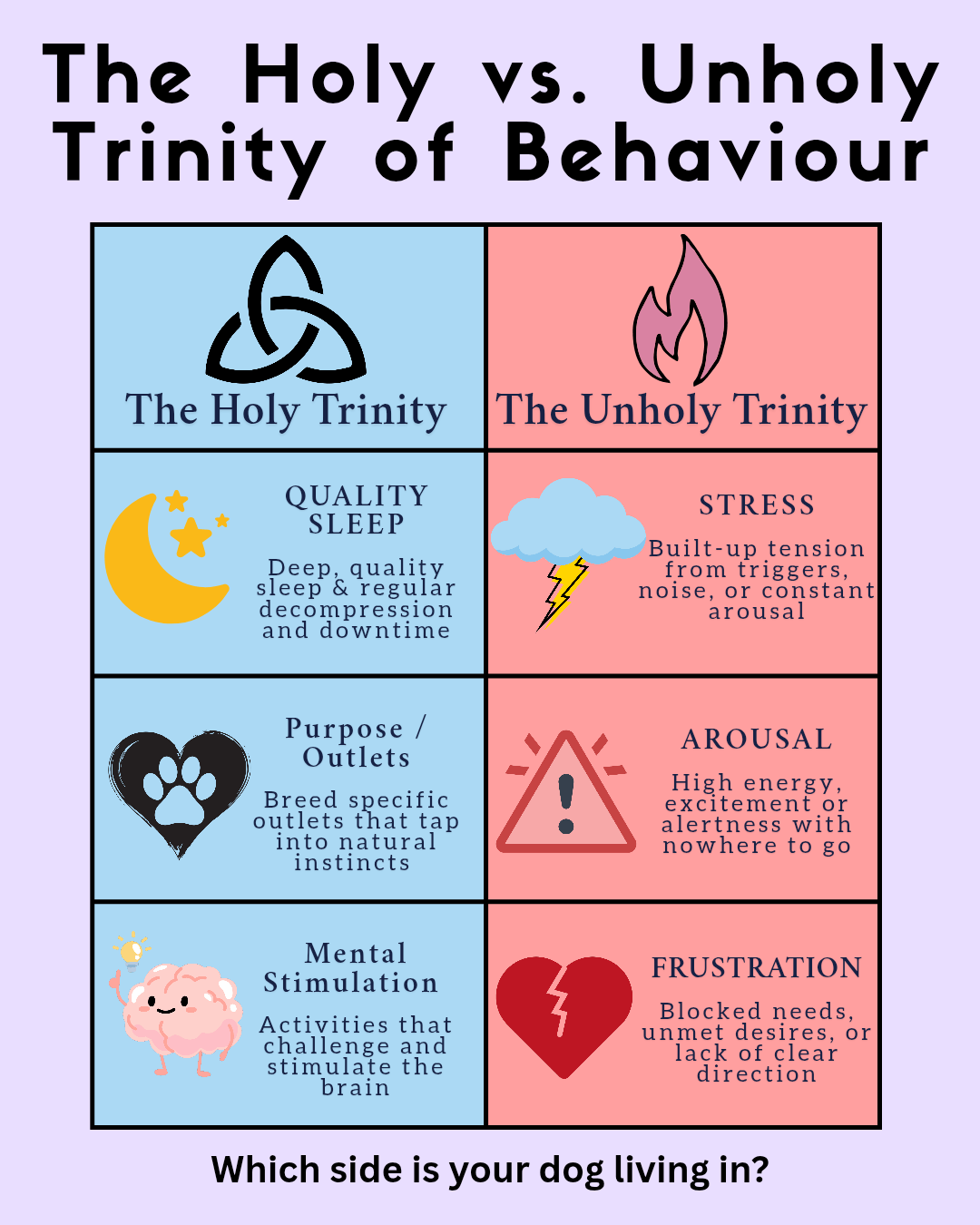Why Your Dog Never Relaxes: 5 Core Elements to Reduce Restlessness & Support Calm
If your dog seems like they never switch off, you’re not imagining it — and you’re definitely not alone.
That constant pacing, the inability to settle, the clinginess, the overreactions, the tension...it's not just in your head. It’s not just “a busy dog.” It’s a sign their system is struggling to regulate.
And the longer that stress builds without release, the harder it gets — not just for them, but for you too.
In this post, I'm not going to slap a “tire them out more” sticker over the problem. Instead, we’re going to dive deeper — into the real reasons your dog can’t relax, and the daily practices that actually make a difference.
I'll break down the core causes of restlessness, unpack the battle between regulation vs dysregulation, and guide you through five key strategies that support calm from the inside out — starting with rest, structure, stimulation, and decompression.
Let’s help your dog finally exhale. And maybe…help you do the same.
My Dog Never Relaxes — Is Something Wrong?
If it feels like your dog never truly switches off — always pacing, pestering, reacting, or struggling to settle — they may have what I refer to as restless dog syndrome (it's not the correct technical term but makes sense right?).
It’s one of the most common (and exhausting) experiences for owners of sensitive, reactive, anxious, or high-energy dogs. We want the best for our dogs, obviously, and seeing them in this state of restlessness constantly not only puts us on the edge with anxiety but also can make us feel guilty too.
So we try more walks. More toys. More training. And yet…nothing sticks. They still can’t rest.
My dog Jasper used to go through these motions constantly and of course my first thought was to increase exercise, run him around more, but even though that tired him out, he still wouldn't be able to relax, in fact sometimes after big exercise sessions he'd seem a lot more restless than before.
It took me a while to realise that he wasn't purposely being hyper or difficult. He was dysregulated. And his nervous system was doing its best to survive in a world that was currently way too much.
What Is Decompression — And Why Does It Matter?
When your dog never relaxes, it’s easy to assume you just need more training, more walks, or more enrichment. But sometimes, the most powerful thing you can offer isn’t more — it’s less.
That’s what decompression is about.
Decompression means removing excess stress, stimulation, and pressure so your dog’s nervous system can finally switch out of survival mode and into a state of rest, regulation, and repair.
It’s about pressing pause — intentionally — even momentarily — to let your dog breathe.
Decompression Builds Regulation
For most reactive, anxious, or overwhelmed dogs, regulation doesn’t come naturally. Their systems are already constantly overfiring. Everything’s a bit too much, and they don’t know how to shut it off. There dogs tend to struggle to learn, listen and often act on impulse.
Decompression isn’t just having a chill day (even though giving your dog a day off at times can be so beneficial and transformative to behaviour). It’s a tool for teaching your dog how to regulate — how to slow their breathing, soften their body, and learn that the world isn’t always something to brace against.
If your dog can’t do this on their own, they need your help to build that skill.
And if that need is ignored? That chronic state of dysregulation becomes the new normal.
Why This Matters: Behaviour and Health
A dog who lives in survival mode isn’t just more reactive or impulsive.
They also:
Struggle to learn or retain training
Have trouble making decisions
Can’t focus or engage
Often develop unpredictable behaviours
Stay stuck in a cycle of “meltdown > poor regulation > meltdown"
And over time, that stress doesn’t just affect behaviour — it affects health.
Chronic stress impacts digestion, immunity, sleep, inflammation, and more if left for extended periods of times. The system is always firing. It doesn’t know how to turn off.
That’s why decompression shouldn’t be a one-off thing that you do periodically. It needs to be part of the daily routine. Just like food, sleep, or walks — decompression is essential.

Common Causes of Restlessness in Dogs
No two dogs have the same routine, thresholds, or quirks (even those living in the same household) — but there are a few common culprits behind constant pacing, whining, or struggle-to-switch-off behaviours.
If your dog never (or struggles) relaxes, these are the areas worth checking first.
#1 - Medical Issues or Pain
Before anything else, rule out pain.
Dogs are masters of hiding discomfort — but one of the earliest signs something’s wrong is when they struggle to lie down, settle, or maintain a comfortable posture.
Arthritis, injury, gut discomfort, chronic inflammation…it all makes resting hard. So if your dog can’t switch off no matter what you try, check in with your vet before assuming it’s behavioural.
I've seen a lot of owners waste a lot of time getting stuck in a cycle of trying to rebuild problem behaviours when the issue all along was a medical issue.
#2 - Exercise: Too Much or Too Little
Yep, both ends of the spectrum can cause problems.
Some dogs aren’t getting enough physical release, so they find other ways to rid that energy which often looks like unwanted behaviours.
Others are overexercised, constantly hyped up, and can’t come down — especially if they’re doing high-arousal activities like non-stop fetch, dog parks, or intense play with no recovery time.
The goal isn’t just “tire them out”
It’s meeting needs without overloading their nervous system.
#3 – Lack of Meaningful Stimulation
Boredom busters are great — but if your dog is literally bouncing off the walls or shadowing you around the house, a frozen Kong isn’t going to cut it (yes even with how much I love them).
Dogs need stimulation that taps into their natural instincts — like tracking, sniffing, solving problems, working for food, or expressing drive-based behaviours.
These activities don't just pass the time. They help dogs feel fulfilled — which is very different from just being “busy.”
Meaningful stimulation + daily enrichment + a solid breed specific outlet = a recipe for met needs and a dog that's ready to sleep.
#4 - Not Enough (or Poor Quality) Rest
Dogs need around 16–20 hours of sleep per day — and not all sleep is created equal.
If your dog is wired all day, jolting awake at every noise, or resisting rest even after activity, they’re not getting the deep, healing REM sleep they need.
Sometimes, the biggest restlessness culprit is a vicious cycle:
Not enough sleep → more stress → more restlessness → even worse sleep
Not getting enough adequate daily rest will lead to dogs being more restless and struggling to actually rest when it's required. It's a horrible cycle to get trapped in. I'll delve a little deeper on this in the next section.
#5 - Stress and Frustration
One of the biggest blocks to relaxation is stress and frustration.
If your dog is constantly scanning every movement, reacting to every sound, pacing up and down, or unable to settle even in calm spaces, it’s likely they’re in a state of dysregulation — and stress has built up past their coping capacity.
Whether it’s reactivity, anxiety, noise sensitivity, overexcitement, frustration or just a stack of micro-triggers without regulation...stress and frustration makes rest almost impossible. It needs to be addressed, not ignored otherwise you'll end up facing a bigger fallout.
👉🏾 Learn more about trigger stacking and how stress adds up over time.

#6 - Lack of Routine and Structure
Some dogs go with the flow. Others? They need the structure or else all hell breaks loose and they start creating chaos.
If your dog constantly pesters you after play or stimulation, can’t “switch gears”, or struggles to self-regulate after activity — chances are, they need clear boundaries around rest, walks, play, and engagement.
Routine helps. But structure is the thing that says:
“It’s rest time now. You don’t have to decide. I’ve got it.”
The Holy vs Unholy Trinity of Regulation
When your dog never relaxes, it's rarely about “just needing more training.”
What’s often happening under the surface is a tug-of-war between two competing forces:
The Unholy Trinity — the cycle of dysregulation
These are the three forces that keep dogs wired, overwhelmed, and constantly on edge which I refer to as the unholy trinity:
Stress
Chronic tension from triggers, unpredictability, or pressure.
Frustration
Unmet needs, unclear expectations, and emotional buildup with nowhere to go.
Overarousal
Too much input, not enough recovery. Constant stimulation without structure.
Together, they create a nervous system that’s always firing — and never allowed to reset.
The Holy Trinity — the foundation of calm and regulation
To counter dysregulation, dogs need these three pillars in their daily lives which I refer to as the holy trinity:
Outlets
Drive fulfilment, breed-specific work, meaningful mental and physical stimulation.
Stimulation & Enrichment
Activities that satisfy your dog’s mental needs. From sniffing, digging, chewing, destroying and more. This is how they decompress through doing.
Sleep
Deep, uninterrupted rest (including REM) that allows for repair, regulation, and a calm baseline. Along with clear routines, predictable boundaries, and the ability to switch off without needing to make every decision themselves.
These are essentials. And when they’re consistently in place, your dog starts to develop the skill of regulation — instead of spiralling through restlessness and chaos on repeat.

My Dog Never Relaxes: 5 Key Ingredients for a More Regulated and Rested Dog
If your dog constantly paces, pesters, or seems unable to switch off, these five areas are where the magic happens — not overnight, but gradually when done consistently and with clarity...
#1 – Meet Their Needs (Without Overloading Them)
Many people who have dogs that have behavioural issues such as reactivity, destructive behaviours, nipping, constant barking and anxiety, struggle to actually meet their needs.
When we talk about meeting needs, we’re talking about intentional, fulfilling, and breed specific outlets — not just “more walks” or “more fetch”.
Think about it, if your dog is a working line collie, a frozen Kong once a day probably won’t cut it. If your dog’s stress skyrockets on walks, dragging them out isn’t therapeutic.
You need to be doing more of the right thing.
This is why you if you haven't considered finding a breed specific outlet for your dog, you're actually missing out!
The right activities satisfy your dog’s brain, body, and instincts — without tipping them into chaos.
#2 - Prioritise Real Rest (Not Just “Lying Down”)
Dogs need 16–20 hours of sleep per day — and not just any sleep.
We’re aiming for deep, undisturbed REM, where stress melts, bodies recover, and brains reset. That kind of good sleep where they twitch about like they're being possessed.
Some dogs fight rest though. And some are too stressed to achieve it.
That’s when we help with:
Forced rest periods (calm crate time, gated rooms, closing stimulation windows)
Lowering stimulation before bed (ditch the hype sessions at 8pm)
Protecting their nap spaces from interruption
A dog that can’t relax, can’t learn. A dog that can’t sleep, can’t heal.
#3 - Track the Patterns
Most owners only notice the chaos. They don’t see what’s feeding it.
That’s why tracking matters. Journaling your progress is one of the most underrated things you can do to provide you clarity and direction on your journey with your dog.
When you jot down your dog’s routines, sleep patterns, daily and weekly reflections, energy dips, or meltdowns…you start to notice things:
“She was more regulated today — oh wait, we skipped the walk and did scent work instead.”
“His restlessness spiked after three days in a row of back-to-back outings.”
“He finally slept properly after I added crate decompression time mid-morning.”
👉🏾 [My Digital Dog Training Journal] helps you log what’s working, spot what’s not, and actually see the progress — all from your phone or laptop (no paper chaos required).
#4 - Build a Predictable and Structured Routine
As I've mentioned, some dogs relax on their own. Most don’t.
That’s why we need to build in structure — a routine that includes clear boundaries, consistent rest periods, and safe spaces where your dog can truly switch off.
Here’s what helps:
Predictable routines (same sleep/wake times, structured play, decompression slots, naps)
Boundaries and expectations (so your dog isn’t constantly “asking” what’s allowed)
Safe havens (think crates, beds, corners — anywhere that feels calm and secure)
If your dog never settles, they might not know when or where they’re allowed to.
#5 - Strip It All Back (Detox the Stress)
If you don't work on reducing and eliminating those stress levels then you will struggle to get your dogs behaviour to change. If your dog stays chronically stressed then their behaviour will probably get worse slowly but surely.
This is where a stress detox comes in handy. By spending a period of time intentionally working on reducing and eliminating stress from your dog you then can start to work on achieving the desirable behaviour you're seeking.
The Paws Of Wisdom Detox Protocol helps reset your dog’s system — not by avoiding life, but by removing unnecessary stressors and focusing on creating better routines.
This is for dogs who are:
Chronically overaroused
Pinging off triggers
Recovering from burn-out
Showing unpredictable and impulsive behaviours
…a decompression focused detox can be the circuit breaker you both need.
By implementing a stress detox you take away the things that stress out your dog and replace them with activities that fulfil and meet your dog's needs to bring them back to a level baseline.
Then, slowly and over time you start to reintroduce activities and stressors back into your dog's routine now they're better equipped to deal with them.
Final Thoughts
If your dog never relaxes, it’s not a sign that you’ve failed — it’s a signal that something in their system needs support.
Whether it’s stress that’s built up, an underlying medical issue, unmet needs bubbling over, or simply too much going on and nowhere to land…regulation is a skill most dogs have to learn. And we get to guide them there.
When you start focusing on rest, structure, outlets, and clarity, things shift. Slowly at first — then steadily.
That chaotic, wired energy? It begins to settle.
That constant pacing? Turns into deeper sleep.
That edgy, unpredictable behaviour? Starts to fade into something more grounded and manageable.
You don’t have to fix everything at once. You just have to start creating the conditions where calm becomes possible — and then a way of life.
You’ve got this. And your dog does too.
Frequently Asked Questions (FAQs): Why Your Dog Never Relaxes
If your dog seems constantly “on” they’re likely struggling with regulation. This can be due to chronic stress, unmet needs, lack of sleep, overstimulation, or unclear routines and boundaries. It’s not stubbornness — it’s usually a nervous system stuck in overdrive.
Relaxation isn’t just something dogs “do” — it’s something we often have to help them learn. Build daily structure, use calm safe havens, incorporate breed specific outlets, and protect their rest. For some dogs, a detox period helps them hit the reset button before true relaxation becomes possible.
Yes — but only with the right support. Dogs don’t grow out of dysregulation, but they can grow into calmness when we meet their needs, reduce pressure, and guide them through the chaos. Progress can be slow, but it’s absolutely possible. And when it is, you won't want to look back!
Walks can be overstimulating, especially if they’re chaotic, full of triggers, or poorly timed. Your dog might return home even more wired, not tired and fulfilled. Consider replacing high-pressure walks with decompression time or breed specific outlets instead.
Pacing is often a sign of stress, discomfort, or restlessness. If your dog can’t settle, it’s worth examining their environment, sleep habits, and stress load. Look for patterns — and if you’re unsure, start tracking their daily rhythms to uncover what’s missing.
Related Reading
A FREE community with downloadable guides and resources, and people who get it.
A simple and structured reset for overstimulated, dysregulated, chaotic dogs.
Simple, clear guidance to help you understand your dog through a regulation-first lens.











